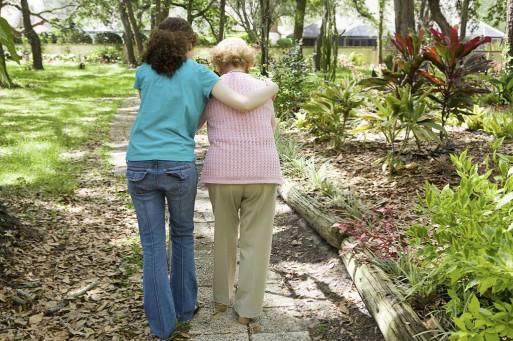Today SevenPonds is speaking with Julie Groves, owner of the occupational therapy organization Therapy In Your Home. Julie has been working in the field of home care since 1980, including experience in working in hospitals and rehabilitation facilities.
Kimberly: How did you get into occupational therapy?
Julie: In college, I realized that I couldn’t decide between psychology, physical therapy and physiology, and my mother figured out that occupational therapy might be what I was interested in based on my interest in doing things, adaption to time and how clients adapt to their situation and how that has to do with living well.
Kimberly: Do you work with a lot of clients near the end of their lives?
Julie: Occupational therapy covers three main specialties: pediatrics, physical disabilities and mental health. It covers the entire lifespan from both the physical and psychological perspective.
Kimberly: What are some common services that you prescribe to clients?
Julie: That depends on which specialty that you are addressing. For the geriatric population at home, you’re looking at how to help them stay home. If it’s for a caregiver, you are looking at how to adapt the environment to make it safer, how to change the task so that they can still stand up and walk to the bathroom, to get their evening medication and do everything they need to do standing up. Maybe we would help them see that they can still do some of those things in the early afternoon when they still have energy, so they can get to bed at night without being so exhausted. Or a person may have just been given a walker by the physical therapist, but we would help them learn how to get their milk out of the refrigerator and carry it over to the table.
There’s a focus on how their outlook is psychologically in understanding and learning about the end-of-life experience with these limitations, with their disability. There’s a focus on function; there’s a focus on helping people change their habits well. A big focus is safe drivers, and sometimes that means helping families figure out: “Is this person safe and how are we going to help them understand that they shouldn’t be driving anymore?”

Credit: Flickr
Kimberly: Can you give us more details on specific areas of life that you try to improve with your services?
Julie: On a basic level, there are persons in the home or at the hospital that focus on helping them move safely: getting in-and-out of a car, up-and-down stairs, in-and-out of a bed, in-and-out of a chair. You can imagine how many people need instruction on sitting down and standing up all day long without injuring themselves. So you’re not only teaching the patient, you’re also teaching the caregivers.
Helping people change their habits so that they stay active longer is also important. It’s about learning how to integrate it and get that into their day so that they don’t stop doing that after they get out of therapy. So, from a psychological standpoint, for a well population, you’re getting questions like: “How do I accept help?”, “How do I ask for help well?”, “How do I set boundaries and say ‘no’?” and “How do I offer help well?”. My particular practice is a combination of being paid by medication, insurance and private pay. In my particular business, we are doing outpatient therapy to provide help to people in their own homes.
Kimberly: How does occupational therapy differ from home caregiving?
Julie: The caregiver is doing their job on their own on an ongoing basis. They’re not skilled providers. They’ve had some training as a caregiver, but not the skills in neurological function, cognitive function, vision, psychological response to a disability. The caregiver is not able to bill insurance and Medicare for their services because it’s not a skilled service.

Credit: Flickr
Kimberly: Do you work with home nurses as well or do you take the place of that role?
Julie: Insurance or Medicare has two buckets. One pays for their hospitalization, their nursing home and their home health agency, which is nursing, social workers and therapy going out to the home. When you graduate from that, you use your second reimbursement, which is your outpatient therapy, which pays for your doctor’s appointments and your therapy in the clinic. We are the outpatient therapy, but we’re providing it in the home. We don’t provide nursing, but the one under home-health does provide nursing. So we’re working right alongside nurses as part of the team.
Kimberly: Can you take us through the process of how you would individualize the care plan for the client?
Julie: We listen. Our company in particular is very patient-centered. We hear what their goals are; we listen to the caregivers’ goals; we look at the environment and how adaptable it is; we find out what they’re hearing from their family and what their family needs. We’re really the eyes and ears for the physicians and for the case manager who sent us out. We only make the changes that the client is willing to do. And that’s a very delicate balance. That’s what our skill is: figuring out how much change can occur, how motivated they are and how much they understand.
Kimberly: Do you have a lot of meetings with your client to boil down a plan?
Julie: It’s an ongoing process. You start with an overview and get started right then with making some changes based on their own priorities. Then you see how they respond and what their learning style is and make plans for the next visit on what you’ll address then.
Please join us next week for part two of our interview with Julie.

 What is Occupational Therapy? An Interview with Julie Groves, Part One
What is Occupational Therapy? An Interview with Julie Groves, Part One



 Flawed Kidney Function Test Discriminated Against Black Patients
Flawed Kidney Function Test Discriminated Against Black Patients

 Harmony Amidst Change: Japan’s Kezouin Fuchu-shi Cemetery
Harmony Amidst Change: Japan’s Kezouin Fuchu-shi Cemetery














